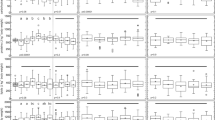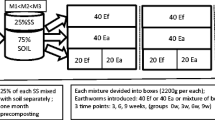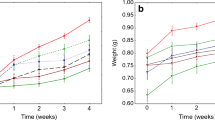Summary
Control individuals contained no lead in the chloragocytes but high α-glycogen rosette reserves. Starvation of contaminated earthworms for 4d caused a lead loss and the chloragocytes possessed fewer debris vesicles than those of unstarved worms, suggesting that the debris vesicles may be the route for at least some of the lead loss. No glycogen deposits were observed in the chloragocytes of starved or unstarved earthworms from contaminated soil. Maintenance of contaminated earthworms in potting compost caused lead losses similar to those sustained by starvation, but the chloragocyte cytoplasm possessed β-glycogen reserves. Specimens maintained in lead-spiked potting compost showed lead levels similar to those of earthworms taken directly from contaminated soil. No β-glycogen accumulations were observed under this enriched regime.
Although the possible interference of lead in carbohydrate metabolism is discussed, the results do not wholly support metabolic inhibition by lead. It is hypothesised that lead sequestration is energy-demanding and that in the absence of an energy-rich diet glycogen stores fail to accumulate. In the presence of an organic-rich medium, elevated lead levels preclude glycogen formation, because of the high sequestration-demand, but at lower lead levels β-glycogen deposits occur if a high organic diet is available.
Similar content being viewed by others
References
Allcroft, R., Blaxter, K.L.: Lead as a nutritional hazard to farm livestock, V. The toxicity of lead to cattle and sheep and an evaluation of the lead hazard under farm conditions. J. comp. Pathol. Ther. 60, 209–218 (1950)
Bhattacharya, S.K.: Inhibition of liver hexokinase by dehydroascorbic acid and alloxan. Nature (Lond.) 184, 1638–1640 (1959)
Dastoli, F.R.: The intermediary carbohydrate metabolism of Lumbricus terrestris. J. Cell. Comp. Physiol. 64, 465–472 (1964)
De Ley, J., Vercruysse, R.: Glucose-6-phosphate and gluconate-6-phosphate dehydrogenase in worms. Biochim. biophys. Acta 16, 615–616 (1955)
Dixon, M., Needham, D.M.: Biochemical research on chemical warfare agents. Nature (Lond.) 158, 432–438 (1946)
Fischer, E.: The chloragosomes of Lumbricidae as cation exchangers. Acta biol. Acad. Sci. hung. 24, 157–163 (1973)
Fischer, E.: Structural basis of cation exchange, complex formation and redox properties in chloragosomes. Acta biol. Acad. Sci. hung. 26, 75–84 (1975)
Fischer, E.: Chloragogenzelle-Eleocyte Transformation, induziert mit Benomyl- und Carbofuran-Vergiftung der Lumbriciden (Oligochaeta). Zool. Anz. (Jena) 197, 225–233 (1976)
Gish, C.D., Christensen, R.E.: Cadmium, nickel lead and zinc in earthworms from roadside soil. Environ. Sci. Tech. 7, 1060–1062 (1973)
Goyer, R.A.: The renal tubule in lead poisoning. I. Mitochondrial swelling and aminoaciduria. Lab. Invest. 19, 71–77 (1968)
Goyer, R.A., Krall, R.: Ultrastructural transformation in mitochondria isolated from kidneys of normal and lead-intoxicated rats. J. Cell Biol. 41, 393–400 (1969)
Iannoccone, A., Boscolo, P., Bertoli, E., Bombardieri, G.: In vitro effects of enzymatic activities of rabbit kidney mitochondria. Experientia 30, 467–468 (1974)
Ireland, M.P.: Metal content of Dendrobaena rubida (Oligochaeta) in a base metal mining area. Oikos 26, 74–79 (1975a)
Ireland, M.P.: Distribution of lead, zinc and calcium in Dendrobaena rubida (Oligochaeta) living in soil contaminated by base metal mining in Wales. Comp. Biochem. Physiol. 52B, 551–555 (1975b)
Ireland, M.P.: Lead retention in toads Xenopus laevis fed increasing levels of lead contaminated earthworms. Environ. Pollut. 12, 85–92 (1977)
Ireland, M.P., Richards, K.S.: The occurrence and localisation of heavy metals and glycogen in the earthworms Lumbricus rubellus and Dendrobaena rubida from a heavy metal site. Histochemistry 51, 153–166 (1977)
Nesbakken, R., Eldjarn, L.: The inhibition of hexokinase by disulphides. Biochem. J. 67, 526–532 (1963)
Roots, B.I.: Some observations on the chloragogenous tissue of earthworms. Comp. Biochem. Physiol. 1, 218–226 (1960)
Schroeder, H.A., Tipton, I.H.: The human body burden of lead. Arch. Environ. Health. 17, 965–978 (1968)
Vallee, B.L., Ulmer, D.D.: Biochemical effects of mercury, cadmium and lead. In: Annual review of Biochemistry. Vol. 41. Ed. Snell, E.E. Annual Reviews Inc., California (1972)
Van Gansen, P.S.: Physiologie des cellules chloragogènes d'un lombricien. Enzymologia 20, 98–108 (1958)
Villar-Palasi, C., Carballido, A., Sols, A., Arteta, J.L.: Sensitivity of pancreas hexokinase towards alloxan and its modification by glucose. Nature (Lond.) 80, 387–388 (1957)
Whittam, R., Wheeler, K.P.: Transport across cell membranes. In: Annual Review of Physiology. Vol. 32 Ed. Hall, V.E. Annual Review Inc. California (1970)
Author information
Authors and Affiliations
Rights and permissions
About this article
Cite this article
Richards, K.S., Ireland, M.P. Glycogen-lead relationship in the earthworm Dendrobaena rubida from a heavy metal site. Histochemistry 56, 55–64 (1978). https://doi.org/10.1007/BF00492253
Received:
Issue Date:
DOI: https://doi.org/10.1007/BF00492253




